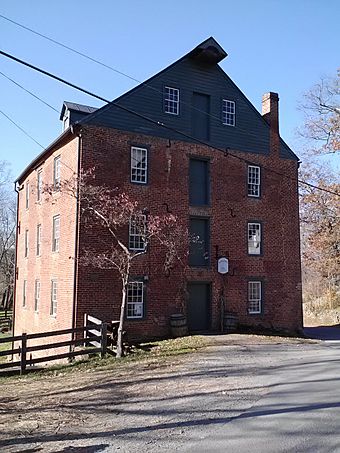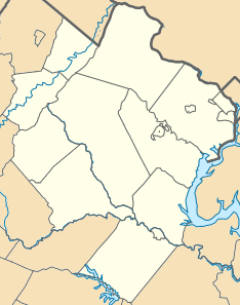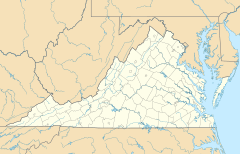Waterford, Virginia facts for kids
Quick facts for kids
Waterford, Virginia
|
|
|---|---|

The Waterford town center in July 2008
|
|
| Country | |
| State | |
| County | |
| Area | |
| • Total | 0.36 sq mi (0.94 km2) |
| • Land | 0.36 sq mi (0.94 km2) |
| • Water | 0 sq mi (0.0 km2) |
| Time zone | UTC−5 (Eastern (EST)) |
| • Summer (DST) | UTC−4 (EDT) |
| ZIP code |
20197
|
| FIPS code | 51-83440 |
| GNIS feature ID | 2807429 |
|
Waterford Historic District
|
|

The Waterford Mill
|
|
| NRHP reference No. | 69000256 |
|---|---|
| Significant dates | |
| Added to NRHP | June 3, 1969 |
| Designated NHLD | April 15, 1970 |
Waterford is a special village in Loudoun County, Virginia. It's known for its old buildings and countryside from the 1700s and 1800s. The whole area is a National Historic Landmark District. This means it's a very important place in American history.
Waterford is located in the Catoctin Valley along Catoctin Creek. It is about 47 miles northwest of Washington, D.C.. It is also 7 miles northwest of Leesburg. In 1810, the center of the United States population was near Waterford.
Contents
History of Waterford
How Waterford Started
Waterford was founded around 1733 by a man named Amos Janney. He was a Quaker from Bucks County, Pennsylvania. Quakers are a religious group known for their peaceful beliefs.
Amos Janney bought 400 acres of land near Catoctin Creek. In the 1740s, he built a grist mill and a saw mill there. A grist mill grinds grain into flour, and a saw mill cuts wood. Because the mills were so successful, the area became known as "Janney's Mill." The town quickly grew as a place where farmers could bring their grain.
Growing into a Village
Amos Janney passed away in 1747. His son, Mahlon, took over the family business. Mahlon replaced the first log mill with a bigger, two-story building. The village kept growing.
In 1780, 12 acres of land were divided into 15 smaller lots. Shops and homes were built on these new lots. By the 1790s, the village was called "Waterford." It was named after the city of Waterford in Ireland. Some of the first people to settle here had lived there before moving to the United States.
New residents continued to arrive from Pennsylvania. These included Quakers, Presbyterians, Lutherans, Baptists, and Methodists. Waterford was also home to African-Americans, some of whom were free and some who were enslaved.
Waterford During the Civil War
When the Civil War began, most people in Waterford were Quakers. Quakers are pacifists, meaning they believe in peace and do not support war. They were also abolitionists, meaning they wanted to end slavery. Because of these beliefs, the Quakers in Waterford supported the Union during the war.
Waterford was the site of a battle between local Union and Confederate groups. These groups were the Loudoun Rangers (Union) and White's Rebels (Confederate). During this time, many Quakers in Waterford helped enslaved people escape to the North.
Waterford Today
In the early 1900s, the town started to show signs of age. To help save and protect Waterford's history, the Waterford Foundation was created. In 1974, this foundation started a special program. This program helps protect historic properties in Waterford. It uses agreements called "easements" to keep open spaces and the look of old buildings. More than 60 such agreements have been made.
Today, Waterford is mostly a place where people live. However, some businesses are still located in the village. For example, the Loudoun Mutual Insurance Company has been in Waterford since 1849.
A National Historic Landmark
Waterford was first recognized as a Virginia Historic Landmark in 1969. Then, in 1970, Waterford and a large part of its surrounding countryside became a National Historic Landmark. This is the highest level of historic importance in the United States.
This means the Waterford Historic District is as important as places like Independence Hall, Mount Vernon, and Colonial Williamsburg. It received this honor because its buildings and landscape from the 1700s and 1800s are so well-preserved.
Some important buildings in Waterford include:
- The mill, built around 1750.
- Arch House Row, also from around 1750.
- Camelot School, built around 1800.
- The Hague-Hough house, which is the oldest house in Waterford, from around 1740.
- The Presbyterian church, built in 1882.
Other important historical sites nearby include the Catoctin Creek Bridge, listed in 1974. The William Virts House was added to the list in 2011.





